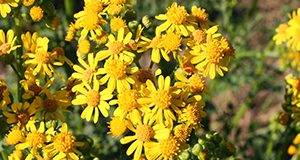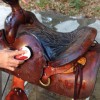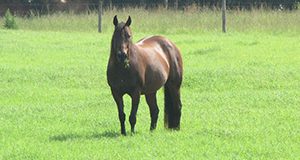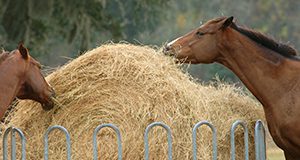Florida's unique climatic characteristics allow for forage production most of the year with a large variety of possible forage choices. Independent of the size of the operation and number of horses, good forage planning can help reduce feeding costs, environmental impacts, and nutritional disorders caused by high-concentrate feeding. With the exception of high-performance animals, horses can meet most of their nutritional needs from pasture. However, achieving this requires careful planning and implementation of a forage production and utilization program. This 9-page document discusses intake and nutrient requirements, pasture planning, forage species, and pasture management. Written by M. Wallau, E. L. Johnson, J. Vendramini, C. Wickens, and C. Bainum, and published by the UF/IFAS Agronomy Department, revised January 2019.
http://edis.ifas.ufl.edu/aa216
Tag: Horses
Common Hazards to Consider During Manufacturing of Feeds for Horses
Horses are uniquely sensitive to fumonisin and ionophores compared to other livestock species. Facilities, particularly mixed-species feed facilities, need to ensure CGMPs, SOPs, and possibly preventive controls are implemented to address those concerns in addition to more general hazards. This 5-page fact sheet discusses common biological, chemical, and physical hazards in horse feeds as well as methods of prevention. Written by Jason M. Scheffler, Taylor N. Langford, Carissa Wickens, and Lori Warren, and published by the UF/IFAS Department of Animal Sciences, June 2018.
http://edis.ifas.ufl.edu/an344
Cressleaf Groundsel (Butterweed) Identification and Management in Pastures
 Butterweed is a winter annual that is toxic to both cattle and horses. This 2-page fact sheet provides an overview of the plant as well as herbicide recommendations. Written by Brent Sellers and Jay Ferrell, and published by the UF Agronomy Department, May 2016.
Butterweed is a winter annual that is toxic to both cattle and horses. This 2-page fact sheet provides an overview of the plant as well as herbicide recommendations. Written by Brent Sellers and Jay Ferrell, and published by the UF Agronomy Department, May 2016.
http://edis.ifas.ufl.edu/ag406
Saddle and Tack Care in Hot and Humid Environments
 The South’s climate is appealing for equestrian activities. While riders enjoy the weather, it creates some challenges in caring for saddles and other tack. When the weather becomes hot and the humidity climbs and the rains are frequent, a tack room can become a breeding ground for mold and mildew. There are several things a rider can do, however, to lower the incidence of mildew on saddles and tack. This 3-page fact sheet was written by Joel McQuagge, Todd Thrift, and Ed Johnson, and published by the UF Department of Animal Sciences, November 2014. (Photo credit: Joel McQuagge, UF/IFAS)
The South’s climate is appealing for equestrian activities. While riders enjoy the weather, it creates some challenges in caring for saddles and other tack. When the weather becomes hot and the humidity climbs and the rains are frequent, a tack room can become a breeding ground for mold and mildew. There are several things a rider can do, however, to lower the incidence of mildew on saddles and tack. This 3-page fact sheet was written by Joel McQuagge, Todd Thrift, and Ed Johnson, and published by the UF Department of Animal Sciences, November 2014. (Photo credit: Joel McQuagge, UF/IFAS)
http://edis.ifas.ufl.edu/an303
El Caballo Pura Raza Española (AN275)
 El caballo Pura Raza Española (P.R.E), conocido también como el Andaluz, es de una elegante raza con ascendencias que se extienden miles de años en el pasado a la región de Andalucía de la Península Ibérica (Cuadro 1). Estos animales desarrollaron gran agilidad, fortaleza, y belleza al lidiar con el terreno escabroso y los animales salvajes, incluyendo toros fieros, de la región.
El caballo Pura Raza Española (P.R.E), conocido también como el Andaluz, es de una elegante raza con ascendencias que se extienden miles de años en el pasado a la región de Andalucía de la Península Ibérica (Cuadro 1). Estos animales desarrollaron gran agilidad, fortaleza, y belleza al lidiar con el terreno escabroso y los animales salvajes, incluyendo toros fieros, de la región.
This 4-page fact sheet is the Spanish lanugage version of AN269, The Purebred Spanish Horse. It was written by María L. Mandina and Jorge R. Rey, and published by the UF Department of Animal Science, December 2011.
http://edis.ifas.ufl.edu/an275
The Purebred Spanish Horse (AN269)
 The Purebred Spanish Horse, also known as the Andalusian or the Pura Raza Español, is an elegant breed with ancestors dating back thousands of years to the Andalusian region of the Iberian Peninsula. The horse evolved to have catlike agility, power, and beauty because it faced rugged terrain and needed to co-exist with local wildlife, including wild bulls. Learn more in this 4-page fact sheet was written by María L. Mandina and Jorge R. Rey, and published by the UF Department of Animal Science, September 2011.
The Purebred Spanish Horse, also known as the Andalusian or the Pura Raza Español, is an elegant breed with ancestors dating back thousands of years to the Andalusian region of the Iberian Peninsula. The horse evolved to have catlike agility, power, and beauty because it faced rugged terrain and needed to co-exist with local wildlife, including wild bulls. Learn more in this 4-page fact sheet was written by María L. Mandina and Jorge R. Rey, and published by the UF Department of Animal Science, September 2011.
http://edis.ifas.ufl.edu/an269
Fundamentals of Bit Selection and Use (AN256)
Choosing an appropriate bit can be a confusing process for horse enthusiasts. This 6-page illustrated fact sheet describes the various types of bits and how to select the best bit for horse and rider. Written by Edward L. Johnson and Kylee J. Duberstein. Published by the UF Department of Animal Sciences, January 2011.
http://edis.ifas.ufl.edu/an256
AN219 El Caballo Cracker de Florida
AN219, a 5-page illustrated fact sheet by Jorge Rey, is the Spanish language version of AN216: The Florida Cracker Horse. It describes this small breed of saddle horse designated “Florida’s Heritage Horse” by the Florida Legislature in 2008 — breed characteristics, history, current status, and events. Includes references. Published by the UF Department of Animal Sciences, June 2009.
http://edis.ifas.ufl.edu/AN219
AN216 The Florida Cracker Horse
AN216, a 4-page illustrated fact sheet by Jorge Rey, describes this small breed of saddle horse designated “Florida’s Heritage Horse” by the Florida Legislature in 2008 — breed characteristics, history, current status, and events. Includes references. Published by the UF Department of Animal Sciences, March 2009.
http://edis.ifas.ufl.edu/AN216

